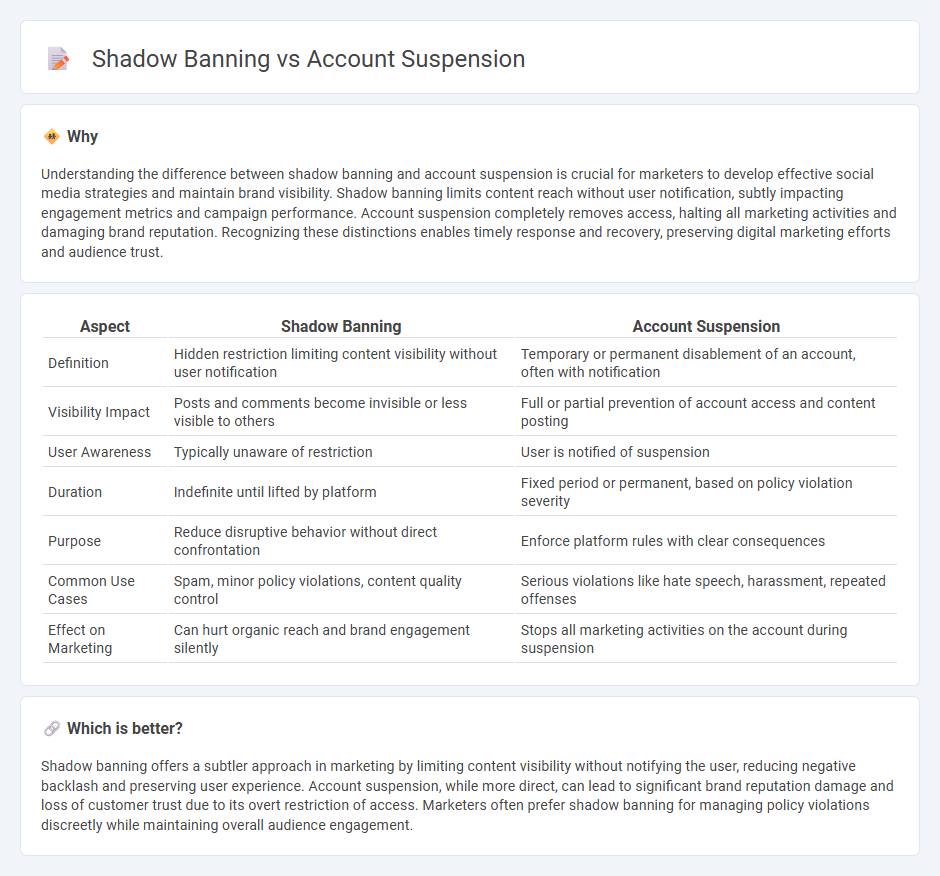
Shadow banning discreetly limits a user's online visibility without notification, affecting content reach and engagement on social media platforms. Account suspension involves a direct and often temporary or permanent removal of user access due to policy violations or harmful behavior. Explore more to understand how these actions impact marketing strategies and user management.
Why it is important
Understanding the difference between shadow banning and account suspension is crucial for marketers to develop effective social media strategies and maintain brand visibility. Shadow banning limits content reach without user notification, subtly impacting engagement metrics and campaign performance. Account suspension completely removes access, halting all marketing activities and damaging brand reputation. Recognizing these distinctions enables timely response and recovery, preserving digital marketing efforts and audience trust.
Comparison Table
| Aspect | Shadow Banning | Account Suspension |
|---|---|---|
| Definition | Hidden restriction limiting content visibility without user notification | Temporary or permanent disablement of an account, often with notification |
| Visibility Impact | Posts and comments become invisible or less visible to others | Full or partial prevention of account access and content posting |
| User Awareness | Typically unaware of restriction | User is notified of suspension |
| Duration | Indefinite until lifted by platform | Fixed period or permanent, based on policy violation severity |
| Purpose | Reduce disruptive behavior without direct confrontation | Enforce platform rules with clear consequences |
| Common Use Cases | Spam, minor policy violations, content quality control | Serious violations like hate speech, harassment, repeated offenses |
| Effect on Marketing | Can hurt organic reach and brand engagement silently | Stops all marketing activities on the account during suspension |
Which is better?
Shadow banning offers a subtler approach in marketing by limiting content visibility without notifying the user, reducing negative backlash and preserving user experience. Account suspension, while more direct, can lead to significant brand reputation damage and loss of customer trust due to its overt restriction of access. Marketers often prefer shadow banning for managing policy violations discreetly while maintaining overall audience engagement.
Connection
Shadow banning and account suspension are both techniques used by social media platforms to moderate user behavior and enforce community guidelines. Shadow banning limits an account's visibility without notifying the user, reducing engagement and reach, while account suspension temporarily or permanently disables the account's access. These methods work in tandem to control content dissemination, prevent spam, and maintain platform integrity.
Key Terms
Policy Violation
Account suspension occurs when a user violates platform policies by engaging in prohibited behavior such as hate speech, spam, or harassment, leading to temporary or permanent restriction of account access. Shadow banning, however, is a less overt form of enforcement where user content is hidden or deprioritized without notification, aiming to reduce the spread of policy-violating material like misinformation or abusive comments discreetly. Explore the differences in enforcement strategies and their impact on user experience to understand platform policies better.
Visibility Restriction
Account suspension results in complete visibility restriction, removing user content and profile from the platform entirely. Shadow banning limits visibility subtly, hiding posts or limiting reach without notifying the user, making content appear less engaged or unseen by others. Explore the distinct impacts of each on online presence and community interaction.
User Notification
Account suspension involves explicit user notification, often via email or platform alert, clearly stating the reason for the suspension and steps for appeal or reinstatement. Shadow banning, conversely, is a covert action where user content visibility is restricted without direct notification, leading users to remain unaware of any penalties. Discover more about these moderation techniques and their impact on user engagement.
Source and External Links
Account Suspension: Common Reasons & How to Manage Appeals - Account suspension occurs when a platform disables access to a user's account due to serious or repeated rule violations, with suspensions being temporary or permanent and often appealable.
Digital Safety | Moderation and Enforcement | Account suspension - User accounts may be suspended permanently or temporarily for severe or repeated policy violations, with an appeals process available for reinstatement if suspension was in error.
Help on your suspended X account - Accounts suspended for violating X Rules can sometimes be unsuspended by following verification steps or filing an appeal if the suspension was mistaken.
 dowidth.com
dowidth.com